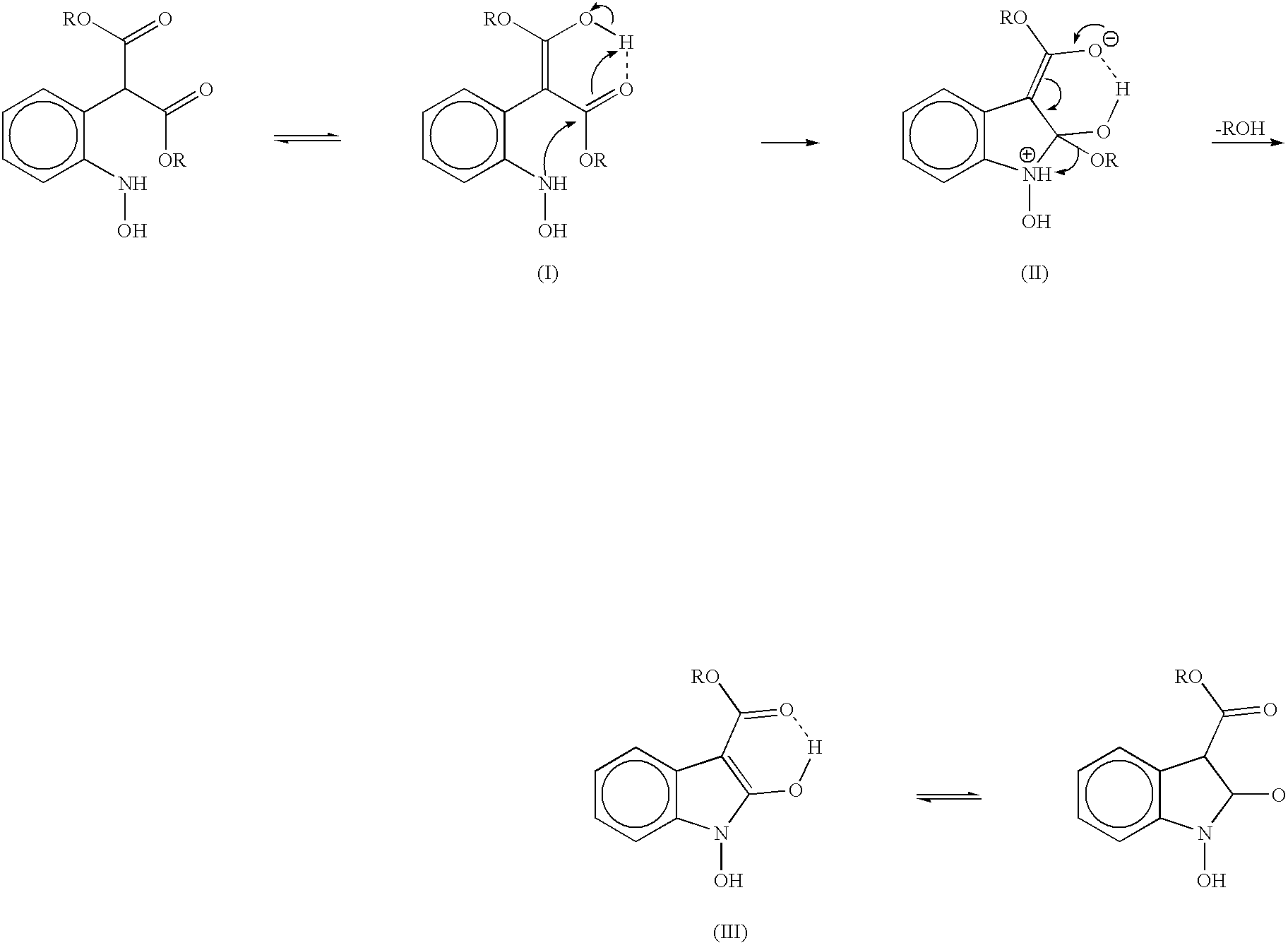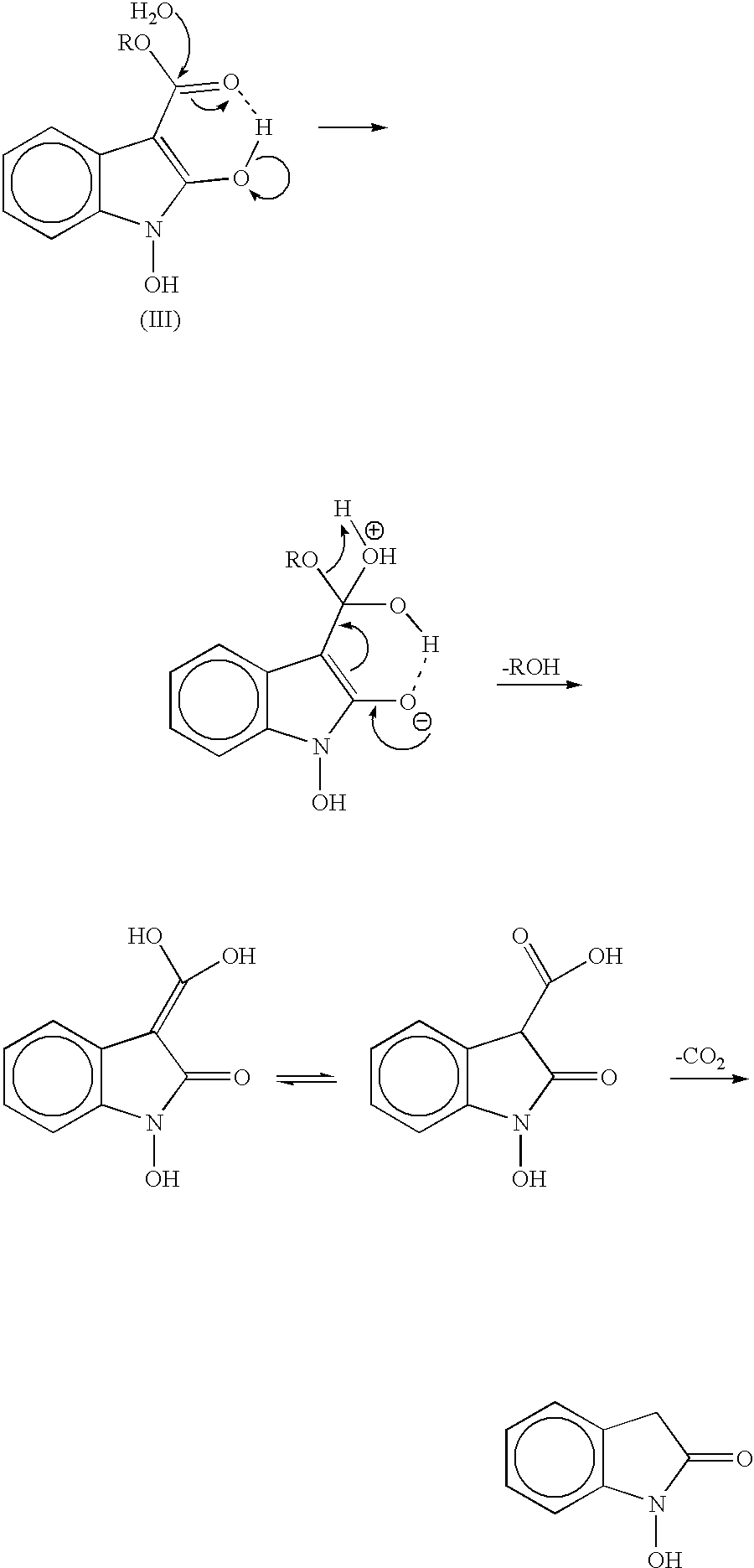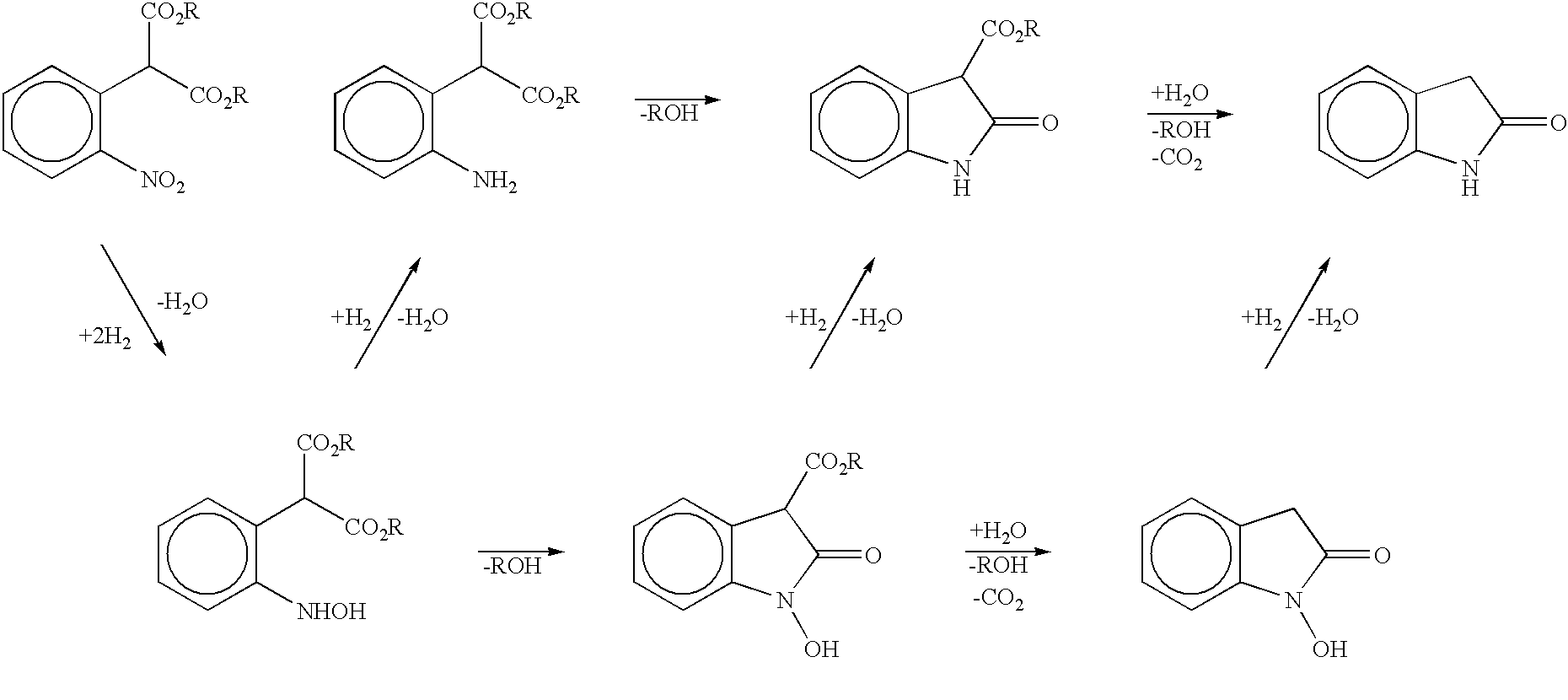Process for preparing 2-oxindoles and N-hydroxy-2-oxindoles
a technology of n-hydroxy and n-oxindole, which is applied in the preparation of carboxylic acid nitrile, chemistry apparatus and processes, and other directions, can solve the problems of lack of commercial availability of these compounds, methods that do not always provide regiocontrol, and other limitations imposed on ring substituents, so as to avoid wasteful isomeric oxindole co-products, economic and environmental benefits, and avoid wasteful isomeric oxind
- Summary
- Abstract
- Description
- Claims
- Application Information
AI Technical Summary
Benefits of technology
Problems solved by technology
Method used
Image
Examples
example 1
Preparation of Dimethyl 4-Chloro-2-nitrophenyl Malonate from 2,5-Dichloronitrobenzene and Dimethyl Malonate
A solution of dimethyl malonate (30.25 g, 0.229 mol) and dimethylformamide (80 mL) was heated to 45.degree. C. and treated with 25% sodium methoxide in methanol (50 mL). Methanol was distilled out at 300 mmHg vacuum, removing 54 mL at a final temperature of 95.degree. C. The resulting mixture of sodium dimethyl malonate in dimethylformamide was cooled to 80.degree. C. and a solution of 2,5-dichloronitrobenzene (20.0 g, 0.104 mol) in dimethylformamide (20 mL) was added over 10 minutes. The reaction mixture was heated at 95.degree. C. for 2 hours to complete the reaction, forming sodium dimethyl 4-chloro-2-nitrophenyl malonate. Vacuum distillation at 40 mmHg removed 55 mL of dimethylformamide. The reaction mixture was cooled and partitioned between water (120 mL) and toluene (100 mL). Then 6N HCl (25 mL) was added to protonate the sodium dimethyl 4-chloro-2-nitrophenyl malonate. ...
example 2
Preparation of 6-Chloro-2-oxindole from Dimethyl 4-Chloro-2-nitrophenyl Malonate
Dimethyl 4-chloro-2-nitrophenyl malonate (30 g, 0.104 mol in an oil prepared according to the method of Example 1), 5% Pt / C (0.15 g), acetic acid (83 mL) and water (3 mL) were charged to an autoclave reactor. The sealed vessel was flushed with nitrogen and then hydrogen was charged to 75 psig. The reaction mixture was mixed with the hydrogen by rapid stirring and heated to 65.degree. C. and maintained at that temperature under 75 psig hydrogen until no further hydrogen uptake was observed. The reaction mixture was then heated to 100.degree. C. to effect the hydrolysis and decarboxylation of 3-carbomethoxy oxindole intermediates. The gas phase containing carbon dioxide was vented, hydrogen was reintroduced at 75 psig and heating was continued at 105.degree. C. under 75 psig hydrogen for 3.5 hr to complete the hydrogenolysis of N-hydroxy oxindole to the oxindole. The reaction mixture was cooled to 60.degre...
example 3
Preparation of Dimethyl 5-Chloro-2-nitrophenyl Malonate from 2,4-Dichloronitrobenzene and Dimethyl Malonate
A solution of dimethyl malonate (30.25 g, 0.229 mol) and dimethylformamide (80 mL) was heated to 40-50.degree. C. and treated with 25% sodium methoxide in methanol (50 mL). Methanol was distilled at 300 mmHg, with the final conditions being 95.degree. C. and 200 mmHg. The resulting mixture of sodium dimethyl malonate in dimethylformamide was placed in a 70.degree. C. oil bath and a solution of 2,4-dichloronitrobenzene (20.0 g, 0.104 mol) in dimethylformamide (20 mL) was added over 30 min. The reaction mixture was slowly heated to 95.degree. C. (2.5 hour hold) to complete the reaction between the 2,5-dichloronitrobenzene and the sodium dimethyl malonate. Dimethylformamide (50 mL) was distilled out at 40 mmHg and then the reaction mixture was partitioned between water (120 mL) and toluene (100 mL). Then 6N HCl (18 mL) was added to protonate the nitroaryl malonate anions. The laye...
PUM
| Property | Measurement | Unit |
|---|---|---|
| temperature | aaaaa | aaaaa |
| temperatures | aaaaa | aaaaa |
| temperatures | aaaaa | aaaaa |
Abstract
Description
Claims
Application Information
 Login to View More
Login to View More - R&D
- Intellectual Property
- Life Sciences
- Materials
- Tech Scout
- Unparalleled Data Quality
- Higher Quality Content
- 60% Fewer Hallucinations
Browse by: Latest US Patents, China's latest patents, Technical Efficacy Thesaurus, Application Domain, Technology Topic, Popular Technical Reports.
© 2025 PatSnap. All rights reserved.Legal|Privacy policy|Modern Slavery Act Transparency Statement|Sitemap|About US| Contact US: help@patsnap.com



